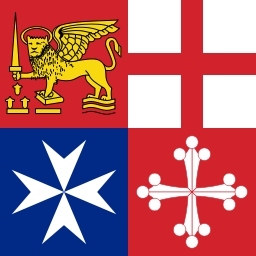I recently promised, somewhat insincerely, to report on how the race of the Four Ancient Maritime Republics came out last Sunday. Insincere, because even though I have seen it here and, via television, elsewhere, I’ve always had the impression that it was a race that interested only the people taking part. I certainly wasn’t picking up any tremors of curiosity from that part of me that wonders about everything.


But we did watch most of it, standing on a mid-course bridge, and about one minute into the 8-minute, 2000-meter contest we had the winner all picked out (the team from Pisa, which has won the last two races, though Amalfi was rowing as if each man had a dagger clenched in his jaws). Although rowing backwards has little appeal for me personally, I had to admire the teams, composed in large part of Italian champions loaded with national, European, and even World titles. For them, this wasn’t some picturesque little jaunt, it was a real race.
Since we were too far away to see the finish, and we were staring straight into the late-afternoon sun, we went home.
Guess what? Those last five minutes have now made history. Not only did Amalfi launch a dazzling sprint that carried them across the finish line 3/100ths of a second faster than Pisa, an hour later the judges decided that three of the four competitors had to be disqualified for technical errors.
This made Venice, the obvious loser trailing for the entire race, the only possible winner.
So the judges and mayors of the four contending cities had a big meeting, while outside some of the fans were so near to starting a small riot that the police and the Carabinieri had to be called in to settle things down. Meanwhile the live-TV commentators trolled the exhausted, baffled and emotional racers for remarks. Everybody was waiting.
The verdict: The race was annulled. For the first time in the 56 years of this competition, there was no winner. It never happened. We were never there. You were just imagining it.
“Venice can’t win this way,” said mayor Giorgio Orsoni in the best sporting tradition, even though it’s a bitter bite, as they say here, when the home team loses, especially when the home team has won more of these races (30) than its three competitors put together.
So what went wrong? I will resist giving you all the details but simply say that Pisa and Amalfi, battling it out in the lead, were guilty of wandering off the legal playing field, while Genova skipped a buoy it was supposed to pass in a certain way. Naturally there were reasons for these infractions which the teams struggled to justify, to no avail. Many people, even ashore, complained about the negative effect the fireboat’s wake was undoubtedly having on the two nearest boats.
So no medals, no glory, nothing but boatloads of grief for everybody, especially Amalfi, which was deservedly proud of its spectacular last-minute push to victory. Or so it thought.
Here is the race, as seen live on national television. I don’t think it’s necessary to know Italian to understand what’s going on. You merely need to have a working knowledge of brilliance, struggle, and crushing disappointment.
And that aroma you may have noticed? It’s the fragrance of revenge wafting from Amalfi, which is the host city for next year’s race.
Trivia: The race was proposed in 1949 by the president of the Tourism organization of Pisa. The fact that it wasn’t invented by an athletic group for its competitive value, but as a neat reason to dress up a shorebound contingent of costumed extras, seems a little odd. But tourists like costumes, and the sporting people can just ignore them.
The four boats were designed by the late, legendary Giovanni Giuponi (in Venice), and built by a Venetian shipyard, originally in wood, later in fiberglass.
The bow of each boat carries a stylized figurehead representing each city’s totem animal (as I think of them): The winged lion of San Marco for Venice, a dragon for Genova, an eagle for Pisa, and a winged horse for Amalfi.
The boat/team colors are: Green for Venice, white for Genova, red for Pisa, blue for Amalfi.
The boats cannot weigh less than 760 kilos (1,675.5 pounds).
The first race was held on July 1,1956, in Pisa. Logical, seeing as it was their idea.
The positions at the starting line are drawn by lot, which is the only fair way to deal with the factor of tide, current, or any other acqueous factor which would clearly help some boats while hindering others. Every city’s stretch of water for this race presents particular little problems which the coaches and coxes make every effort to recognize. As it happens, Pisa, which had the lead for almost the whole race, was rowing in the worst position. Hats off, oars up, wave your flag or handkerchief, because they deserve it.
If the teams have been here for a week, studying the course, you might well wonder how the coxes of three boats could have made the mistakes they did. Lino’s explanation: They were of course looking for the best little thread of extra current to help them, and didn’t pay attention. Or thought nobody would notice, which is my theory.
